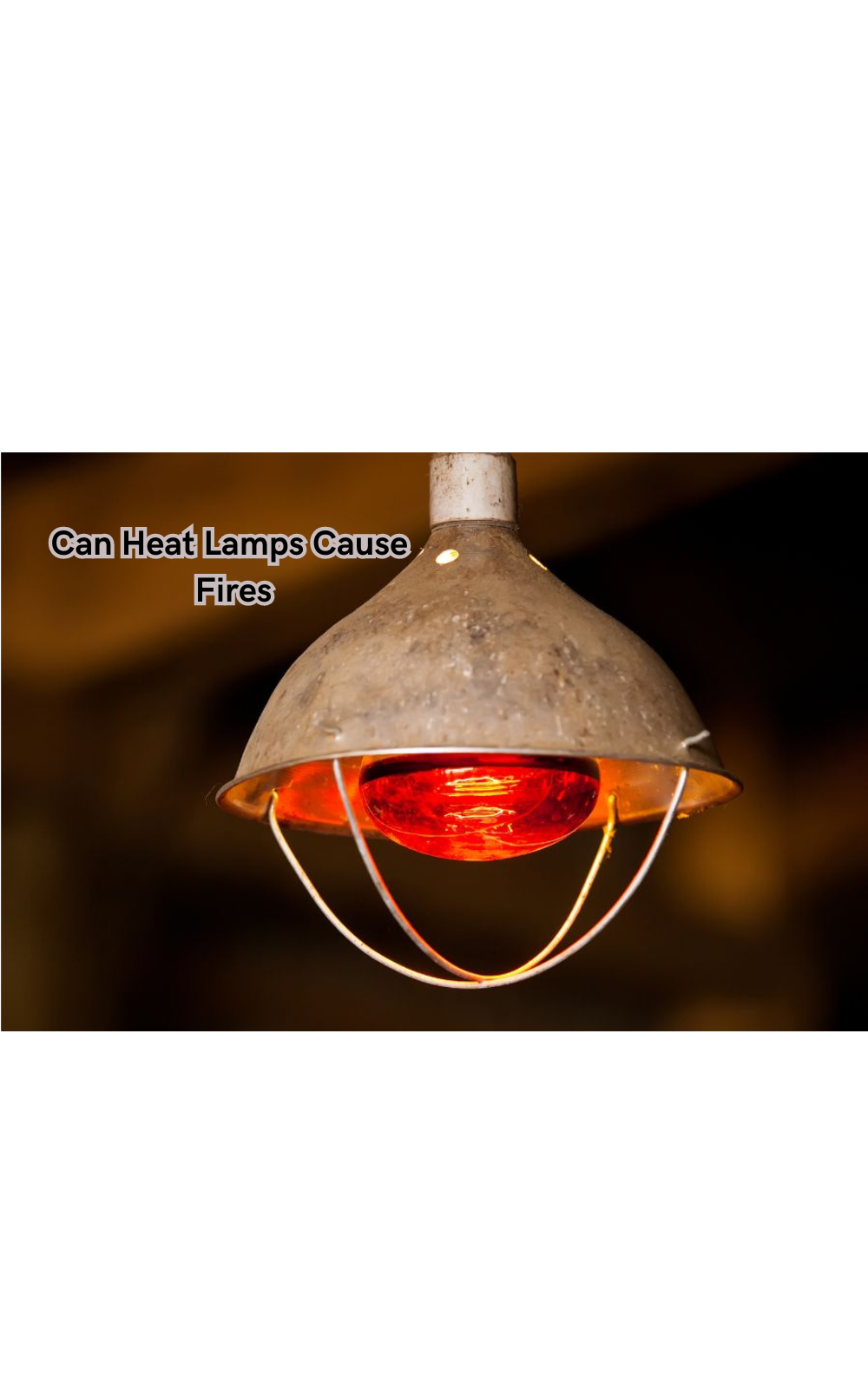Can Heat Lamps Cause Fires
Understanding the risks associated with heat lamps and being aware of proper usage guidelines are essential for preventing fire hazards. Heat lamps serve a practical purpose, from warming up outdoor spaces to keeping pets cozy, but if not used correctly, they can pose a fire risk.

Safety is paramount when using heat lamps for various applications. Many individuals utilizing these devices have valid concerns about whether they can cause fires.
Understanding the risks associated with heat lamps and being aware of proper usage guidelines are essential for preventing fire hazards. Heat lamps serve a practical purpose, from warming up outdoor spaces to keeping pets cozy, but if not used correctly, they can pose a fire risk.
Let's delve into the factors that influence the possibility of heat lamps causing fires and explore safety measures to ensure their safe and effective operation in different settings.
What Are Heat Lamps?
Before discussing the potential fire hazards of heat lamps, it's crucial to understand what they are and how they work. Heat lamps are electric devices that emit infrared radiation, producing heat similar to natural sunlight. These lamps consist of a bulb, reflector, and housing unit to protect from any contact with the hot bulb.
Additionally, brooder heat lamps are often used in farming and agriculture to warm young animals, such as chicks or piglets. They typically have a metal guard surrounding the bulb to prevent direct contact with the heat source. A radiant heat source attempts to mimic a mother hen's warmth, calming the animals.
Types of Heat Lamps
Heat lamps are available in various types, including incandescent, infrared, and ceramic heat lamps. Each type has its unique features and uses, but they all share a common purpose of generating heat.
- Incandescent heat lamps: These produce light and heat through the use of a heated filament that glows when an electric current passes through it. Heat bulbs typically have a red or clear glass envelope and are used for overhead heating in commercial settings, such as restaurants or outdoor patios.
- Infrared heat lamps: They emit electromagnetic radiation in the infrared spectrum, which produces warmth by heating up objects rather than the air.
- Ceramic heat lamps: These lamps use a ceramic heating element to generate heat without emitting light, making them ideal for applications where light is not desired. Light bulb-shaped ceramic heat lamps are commonly used for reptile terrariums and other small animal habitats.
What Causes Fires from Heat Lamps
Here are some common causes of fires from heat lamps:
Overheating:
Heat lamps are designed to emit infrared radiation, which heats up surfaces and objects. But, leaving the heat lamp on for too long can cause the temperature to rise to dangerous levels, leading to combustion.
Flammable materials in close proximity:
One of the significant risk factors is placing a heat lamp too close to combustible materials, such as curtains or bedding. The intense heat emitted by these lamps can easily ignite nearby objects if not given enough clearance. It's essential to follow manufacturer guidelines on how far away the lamp should be from any combustible materials.
Electrical malfunctions:
The wattage or power output of a heat lamp determines how hot it gets and, consequently, the potential fire hazard. Higher-wattage lamps produce more significant amounts of heat and have a higher risk of causing fires if not used correctly.
It's crucial to select the appropriate wattage for your specific application and never exceed the recommended wattage for your lamp. Surge protector power strips can also help prevent electrical malfunctions and fires. Take preventative measures such as unplugging the lamp when not in use and regularly checking for any signs of damage or wear.
It's worth noting that while these are the most common causes of fires from heat lamps, there may be other factors at play as well. It's always best to err on the side of caution and take necessary safety measures when using heat lamps. In any huge risk, take a fire extinguisher or fire suppression system.
Can Heat Lamps Cause Fires in Different Settings?
Yes, in some circumstances, heat lamps can cause fires in different settings. Heat lamps can pose a fire hazard in various settings if not used correctly. Let's take a look at some common scenarios:
- Indoor use: Heat lamps are commonly used for keeping pets warm or providing heat to reptile enclosures. To prevent fires, it's essential to keep the lamp away from flammable materials and ensure it is securely mounted or placed on a stable surface.
- Outdoor use: Heat lamps are also frequently used to provide warmth on patios, decks, and other outdoor spaces during chilly evenings. When using heat lamps outdoors, make sure they are designed for outdoor use and follow all safety precautions to prevent potential fires.
Traditional heat lamp bulbs can also be used for heating food in restaurants or catering events. In chickens farm, heat lamps are used to provide warmth for young animals. Mother hens are often equipped with heat lamps to keep their eggs warm until they hatch. How many chicks survive depends on the heat lamp providing enough warmth to keep them safe from cold. In these settings, it's crucial to use heat-resistant bulbs and follow proper guidelines to prevent fires.
How to Prevent Heat Lamp Fires
To minimize the risk of heat lamps causing fires, here are some essential safety measures to keep in mind:
- Choose the right lamp: Select a heat lamp that is suitable for your intended use and follow all manufacturer guidelines regarding proper usage. Supplemental heat sources, such as heat pads or heated mats, maybe a safer alternative for some applications.
- Keep combustible materials away: Make sure there is enough clearance between the heat lamp and any flammable materials. The recommended distance will depend on the type of material used, so it's crucial to refer to manufacturer guidelines.
- Monitor usage time: It's vital to turn off heat lamps after a specific amount of time or when not in use. This will prevent overheating and potential fires.
- Regularly inspect and maintain: Regularly check for any damage or wear and tear on the heat lamp and replace any worn or damaged parts as needed.
Additional Safety Tips
Some additional safety tips to keep in mind when using heat lamps include:
- Always supervise children and pets when using heat lamps.
- Do not use damaged or frayed cords with your heat lamp.
- Make sure to unplug the heat lamp when not in use and before changing bulbs.
- Avoid using extension cords with heat lamps.
- Regularly clean dust and debris from the lamp and surrounding area to prevent any potential fire hazards. Every 2 or 3 years ago, replace the heat lamp with new heat bulbs.
Following these safety measures and using heat lamps properly can help prevent fires and ensure their safe usage in various settings.
FAQs
Is it okay to leave a heat lamp on overnight?
It is not recommended to leave heat lamps on overnight, as it can increase the risk of fire hazards. If necessary, closely monitor usage time and make sure to turn off the lamp when not in use.
Can I use an extension cord with a heat lamp?
It's best to avoid using extension cords with heat lamps as they may cause overheating and potential fire hazards. Instead, plug the lamp directly into a wall outlet or use a surge protector power strip.
What should I do if my heat lamp catches fire?
If your heat lamp catches fire, immediately unplug it and extinguish the flames using a fire extinguisher or suppressant material designed for electrical fires. Call emergency services if needed.
Does a heat lamp use a lot of electricity?
It depends on the wattage of the heat lamp and the length of time it is used. Be sure to choose an appropriate wattage for your intended use and monitor usage time to prevent excessive energy. For less electricity usage, you can opt for energy-efficient heat lamps or use alternative heating sources.
Final Thoughts
Heat lamps have the potential to cause fires if not used properly. It's crucial to follow safety guidelines, such as ensuring the lamp is stable, keeping combustible materials away, and never leaving it unattended. Regular maintenance and monitoring for any signs of wear or damage are essential.
Educating oneself on the risks associated with heat lamps and taking necessary precautions can significantly reduce the likelihood of a fire. Remember, safety should always be the top priority when using heat lamps to prevent any accidents or disasters.
